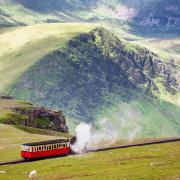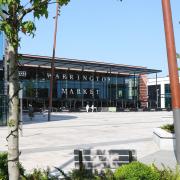A pink shirt and clashing green trousers are considered fashionable for this kind of assignment thanks to Michael Portillo. If you’ve watched his Great British Railway Journeys you’ll be familiar with the genial travel guide and onetime politician’s extravagant dress sense. I am now similarly attired for a look at Bradshaw’s Cheshire. Taking my lead from Michael, I’ll be using an 1863 Bradshaw to guide me around the county’s railways. George Bradshaw (1800-53), the cartographer, publisher and printer, was the brains behind these eponymous and popular handbooks.
What you notice from Portillo’s programmes, and the guides, is that they’re not just about railways. My guide tells me not just where to go and how, but where to stay and what to do with myself. To test this out and establish how Cheshire has changed over 150-plus years, I’m sampling a figure-of-eight route, setting off firstly for Chester. Let’s hope this journey goes as rip-roaringly as Bradshaw, a master of hyperbole, has me believe it will. I start in Shrewsbury and enjoy a bit of Wales before crossing the border at Saltney and soon after departing the station we’re across the Dee ‘by the largest cast-iron girder bridge in the kingdom’.

Chester
Where Bradshaw suggests visiting The Cheese Market (in the Old Linen Hall), the Shire Hall and Assize Court – 'an imposing Grecian pile’
Bradshaw recommends that I bivouac at the Albion, which I hoped was today’s Albion Inn, the last remaining classic Victorian corner street pub within Chester’s walls, but this apparently dates from the late-1880s. Another possibility is today’s Town Crier, built in 1865 (or thereabouts hopefully), whose original name was either the Queen Commercial Hotel or the Albion Hotel. Grade II Listed and standing opposite Chester station it was designed for the railway ‘overflow’, 1st Class passengers having already been siphoned off by the Queen, which stood on the opposite corner. Bradshaw reckons Chester to be a ‘genuine Roman city’. The population is 31,110 (around 80,000 today) and my guide mentions the walls, Rows and cathedral. The station, ‘where four lines meet’, is 1,010 feet long, – quite a whopper relatively speaking. Bradshaw digresses with a list of local worthies, or ‘natives’ as he terms them, including Sir John Vanbrugh, who grew up here, and he can’t resist a mention for his namesake Henry Bradshaw (c.1450-1513), a poet born in Chester. Bradshaw throws in an itinerary, which includes: The Cheese Market (in the Old Linen Hall); the Shire Hall and Assize Court (‘an imposing Grecian pile’); the old castle; and the race course – the Roodee. I must away though as tempting as Chester is I have much more to see.

Crewe
Where nearly 2,000 are employed in the railway workshops and a new engine ‘is turned out every Monday morning
I make the short hop to Crewe, at the centre of my figure-of-eight. Population 8,159 (a bustling 75,000 today), Crewe took off as a railway town and Bradshaw faithfully reports that nearly 2,000 are employed in the workshops where a new engine ‘is turned out every Monday morning’. My jolly guide may not have a list of activities for me in Crewe, however, he does nominate the Crewe Arms for my hostelry and it would be rude not to for this is the first constructed railway hotel, built in 1830, and therefore sits handily next to the station. If I want to stay even closer to Crewe’s platforms, well, Bradshaw also mentions the station’s refreshment rooms as a possible overnighter.

Congleton and Macclesfield
Where a visit to nearby Mow Cop – 'a mountain in miniature' – is recommended
Next, I want to experience the splendours of Congleton and Macclesfield so must exit the county again to change trains. I head along the nine-mile Crewe-Kidsgrove line along which Bradshaw mentions stations at Radway Green (a Beeching closure of 1966) and Alsager but the branch ‘affords no extraordinary or interesting feature’ so we’re soon at Kidsgrove (Staffs). Heading off again I’d love to alight at Mow Cop and Scholar Green but this was another Beeching closure (1964), which is why the station was immortalised in the Flanders & Swann song, The Slow Train, a lament for all those little stops culled by the bad doctor. Bradshaw likes Mow Cop, which he describes as ‘a mountain in miniature’. Arriving in Congleton I’m directed to the Lion and Swan, a family-run, traditional coaching inn. The town is old ‘with manufactures of silk and cotton’ and has a population of 12,344 (about 26,500 today). There are ‘several old timbered houses’ (à la Lion and Swan) ‘large silk, cotton and ribbon factories, town hall, and good grammar school’.
I must move on though as Bradshaw has me salivating at my next hop, the route from Congleton to Macclesfield being ‘rich in natural beauties’. Macclesfield has the Macclesfield Arms and the Angel awaiting if I fancy resting my noggin. The trouble is the former, on Jordangate, closed in the 1980s while the latter, on Chestergate, is now a bank. Disappointed that I might not be staying the night I nevertheless gen up on the place, a market town of 36,101 souls (about 51,500 today), which has stuff that ‘must be viewed’: St Michael’s Church (with tombs), Christ Church (more tombs), the Town Hall, Free Grammar School and School of Design, Public Park, silk and cotton factories. I am made up like a silk shirt.

On to Cheadle Junction
Where the best thing to see is the Viaduct at Stockport
We continue through the village of Prestbury (population just 358, but nudging 3,500 today), then to Poynton and Bramhall. We’ve attained Cheadle Junction, the ‘point of union’ (ie the junction) with the mainline from Crewe to Manchester, which we’ll transfer to in order that we can get back to Crewe. Bradshaw’s Cheadle (population 6,115 but around 26,500 today) is actually Cheadle Hulme, historically part of Cheshire but today a suburb of the Metropolitan Borough of Stockport. Bradshaw shortchanges me a bit with Cheadle as he’s far more interested in Stockport, so when he’s supposed to be telling me what to see in Cheadle he diverts instead to a lengthy dissertation on the Viaduct at Stockport, ‘one of the railway marvels of our time’. I’m not going that far though as I’m heading back to Crewe station.

Sandbach
Where the panorama extends to the Welsh Mountains to the west and the Derbyshire hills to the east
Bradshaw deals with Wilmslow, Alderley, Chelford and Holmes Chapel in rather summary fashion. Near Chelford, he mentions Tatton Park where I can pop in on Lord Egerton apparently. Sandbach (population 3,252 but about 18,000 today) is the last stop before Crewe and Bradshaw directs me to The George, which has occupied a familiar spot in the High Street for more than 200 years. My guide praises the town, ‘occupying a very pretty situation on the banks of the River Wheelock’ with ‘a panorama that extends from the Welsh mountains in the west, to the Derbyshire hills in the east’. I’m tempted to hang about but I must away to complete my figure-of-eight.

Nantwich
Where the 'decent and staid' Lamb Hotel was once the place to stay and cheese is on the menu
Having popped into Crewe for a second time I’m now heading south-west back towards my starting point of Shrewsbury. Nantwich (population 6,225 but around 18,000 today) was ‘formerly celebrated for its salt mines, but is now famous for its cheese’. Bradshaw recommends the Lamb Hotel, which would be the present building, dating to 1861 and Grade II Listed (there was an earlier inn of the same name, on the same site, that dated back to the mid-16th century). Sadly it’s no longer a hotel, its hostelry days ending this century when it was converted for residential and commercial purposes. Pevsner described the building as ‘decent and staid’. After Nantwich I’m out of the county and back in Shropshire so it’s time for me to pack my handbook away, take a walk around Nantwich and see if I can find any of that cheese Bradshaw mentioned.































